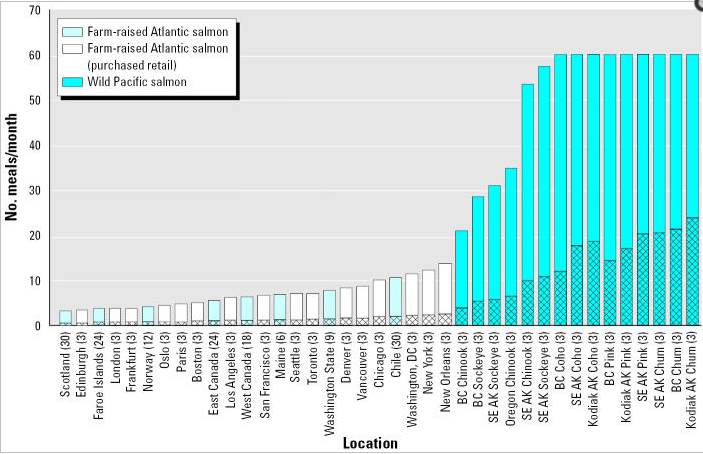The health benefits of having an optimal omega-3:6 ratio and favorable vitamin D levels have effects resonating throughout every field of medicine. But those aren’t the only reasons why you should consider wild caught salmon…
1. Studies have shown that adults in the United States do not meet dietary requirements of omega-3 fatty acids and fish intake. Optimally, your omega-6 to omega-3 ratio should be close to 2:1, although some sources say that this ratio varies between 1:1 and 4:1 based on the disease of concern. We’ve heard it before, but omega-3s help decrease total body inflammation, support vascular integrity, cardiovascular health, and support brain function, Most people who eat a western diet have a ratio somewhere between 15:1 and 50:1. Wild-caught salmon is high in omega-3s to help improve your ratio!
2. Along the same lines, farm-raised salmon are fed grains which subsequently increase your omega-6 intake.A high omega-6:3 ratio has been correlated with increased pathogenesis of cancer, cardiovascular disease, inflammatory diseases, and autoimmune diseases. The severity of the disease and probability of pathogenesis occurring due to these ratios is multifactorial and includes genetic predisposition, but this is one factor you have control over.
3. Farm-raised salmon are given antibiotics which contributes to resistance to antibiotics. Additionally, the antibiotics in our food contribute to health problems including possibly childhood obesity. The FDA has even concluded that many of the drugs used in food animals are a risk to human health.
4. Optimal vitamin D levels are important for prevention and treatment of osteoporosis, psoriasis, seasonal affective disorder, autoimmune disorders, and optimal immune function amongst other indications. Wild caught salmon have been shown to have between 75% and 90% more vitamin D3 compared with farmed salmon.
5. Wild-caught salmon is a powerhouse for other nutrients including vitamin A, B12, folate, vitamin B6, pantothenic acid, niacin, riboflavin, thiamine, selenium, manganese, copper, zinc, potassium, sodium, phosphorus, magnesium, iron, and calcium.
6. Health risks associated with exposure to farm-raised salmon contaminated with PCBs, toxaphene, dieldrin, dioxins, and polybrominated diphenyl ethers are greater than exposed to the same contaminants in wild salmon. These chemicals are associated with numerous adverse health effects including increased incidence of cancer, susceptibility to infectious diseases, altered behavior, cardiovascular disease, diabetes, endometriosis, and many other conditions. As you can see from the figure below, the risk-based consumption advice from Foran et al shows increased safety of consumption of Wild Pacific salmon. They recommend that farmed salmon should be limited, from less than one meal per week to three meals per week depending on source, to meet the World Health Organization (1998) target dose for dioxin equivalents (1 pg/kg/day).

“Risk-based consumption advice for Atlantic salmon purchased from farms, farmed Atlantic salmon purchased from retail stores, and wild Pacific salmon. Solid bars indicate the number of meals per month to limit dioxin intake to 1 pg TEQ/kg/day, the lower end of the WHO TDI (1–4 pg TEQ/kg/day). Patterned bars indicate the number of meals per month to limit dioxin intake to 20% above the average (65 pg TEQ/day) U.S. adult intake level. Abbreviations: AK, Alaska; BC, British Columbia; SE, southeastern. Edible tissue levels of DLCs were reported by Hites et al. (2004a). Wild salmon capped at a practical consumption rate of 60 meals/month or approximately 2 meals/day.” (Foran et. al.)
So what’s the catch? Well, there is one thing to consider. You want to be careful about the amount of mercury you consume. In general, the bigger the fish you eat, the more mercury has been bio-accumulated. One study funded by Canadian fishing industry reported that wild salmon had 3x the amount of mercury as farm-raised, but let’s be honest, there is a bit of a conflict of interest there. Other studies have shown that there is no notable difference between mercury levels of wild-caught vs. farm-raised.
This study found that mercury levels were well below the the Health Canada guideline (0.5 microg/g) and the US-FDA action level (1.0 microg/g) though perhaps limiting your intake to the recommendation given by the American Heart Associations of 1 serving of salmon per week as a substitute for another protein source such as red meat or poultry is a reasonable way to reap the benefits while limiting the mercury.
Wild Alaskan salmon is just one of the power foods we will be offering at the American Association of Naturopathic Physicians’ Whole Health reception tomorrow night for the members of US Congress and their staff at the Rayburn foyer. So, if you’re a legislative aide, legislative assistant, healthy policy assistant, legislative correspondent, advisor, or otherwise working on the hill, please join us tomorrow night at 5pm!
